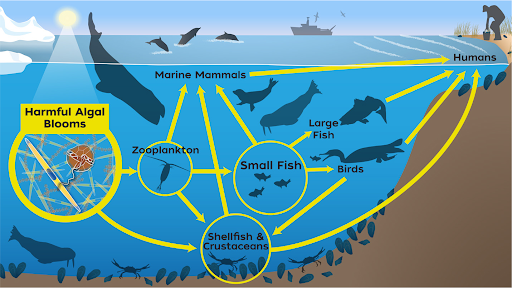Climatic changes in Arctic Alaska are resulting in more harmful algal blooms (HABs) for the region, signaling a potential growing threat to human and ecosystem health. Over the last decade, several research groups have discovered large accumulations of the resting stages of HAB species on or near the seafloor, laying dormant in unfavorably cool Arctic waters. The dormant cysts are a ticking time bomb set to go off as waters warm, creating favorable conditions for large toxic algal blooms to form.

A new NCCOS-funded study discusses the challenges of monitoring and managing two toxins associated with the blooms — saxitoxins, produced by Alexandrium catenella, and domoic acid, produced by multiple species in the diatom genus Pseudo-nitzschia.
Algal blooms, and the toxins they produce, immediately threaten an array of marine life and the coastal communities who rely on fish and shellfish resources. Increased exposure to HAB toxins may also have long-term, cascading effects for the region.
Monitoring and managing HABs in Arctic Alaska is a significant challenge. The authors cite “lack of information, limited infrastructure, and unique spatial challenges inherent in Alaskan land- and seascapes” as key obstacles. Long stretches of sparsely populated coastlines and limited communication and transportation infrastructure make sample collection and analysis costly and complicated.
Recent advancements in technology may provide critical monitoring tools for the region. New sensors, capable of detecting and quantifying HAB cells and toxins in situ, allow data to be both collected and transmitted continuously from remote locations to shore-based scientists and managers. These advancements are expected to improve knowledge and management of HABs in the region, ultimately leading toward a healthier coastal community and ecosystem.
The study was led by scientists at the Woods Hole Oceanographic Institution in collaboration with colleagues from NOAA’s Northwest Fisheries Science Center and other researchers. Support for the research was also provided by the U.S. National Science Foundation’s Office of Polar Programs, NOAA’s Arctic Research program, NOAA’s Center for Coastal and Ocean Studies ECOHAB Program, and U.S. National Park Service Shared Beringian Heritage Program.
